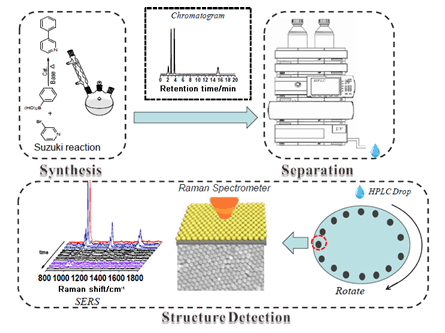摘要/Abstract

表面增强拉曼光谱(SERS)因极高的检测灵敏度及丰富的光谱指纹信息而在物质的结构鉴定方面得到广泛应用,但对于复杂混合物的SERS光谱解析仍存在较大挑战,因此并不能有效用于直接实时监测化学反应过程.本工作以有序Au纳米粒子二维阵列膜为基底,将SERS技术与高效液相色谱(HPLC)联用,充分发挥两者在高灵敏度检测和高效分离方面的优势,实现了对苯硼酸和3-溴吡啶的Suzuki偶联反应的实时连续分离和检测.研究表明该反应体系的混合液的HPLC中检测到保留时间分别位于2.1 min,2.8 min,3.6 min,15.3 min的四种不同物质,第一种物质对应于反应物苯硼酸;第二、三种物质分别对应3-溴吡啶和主产物苯基吡啶,它们的SERS光谱特征与标准物完全一致,最后一种物质的SERS光谱特征与联苯一致,由此说明反应过程中的副产物为联苯.通过对最终反应物进行层析分离提纯得到主产物,NMR谱特征表明其为苯基吡啶,这与SERS研究结果一致,而副产物联苯的产率较低,提纯困难而无法通过NMR分析获得其结构.由此可见,SERS-HPLC联用实现了分离与鉴别的功能集成,有望发展成为一种具有潜在应用前景的有机反应历程的实时检测工具.
关键词: 表面增强拉曼光谱, 高效液相色谱, 联用技术, Suzuki反应, 实时监测
The surface enhanced Raman spectroscopy (SERS) has been employed in the structural characterization successfully due to its ultra-high sensitivity. However, it is still remained the significant difficulties in the precise interpretation of spectroscopy. Thus, it was not developed as the promising tool for monitoring the organic reaction directly. Herein, by using the two dimensional Au nanoparticles array film as substrate, the SERS was hyphenated with high performance liquid chromatography (HPLC). The individual advantages of high sensitivity of SERS and high efficiency in separation of HPLC were combined together, and it was extended successfully to real-time monitor of a Suzuki coupling reaction between 3-bromopyridine and phenylboronic acid. Firstly, the retention time and SERS spectra of standard solution of 3-bromopyridine and phenylboronic acid were performed respectively. It was beneficial for distinguishing the reactants of the current Suzuki reaction. After the reaction was proceeded for about 5 min, the mixture was sampled for the HPLC-SERS detection. It demonstrated that the chromatogram peaks located at 2.1 min and 2.8 min were contributed to phenylboronic acid and 3-bromopyridine, while 3.6 min and 15.3 min were originated from the reaction products. The solution collected at different retention times were then flowed through the catheter and dropped to the surface of Au nanoparticles arrays sequentially. The SERS spectra features were well agreement with that of 3-bromopyridine at 2.8 min, while the SERS spectra was absent for phenylboronic acid at 2.1 min due to its weak adsorption on Au surface. For the products, the typical vibrational modes of 3-phenylpyridine and diphenyl were observed in the SERS spectra, suggesting the composition of the product and byproduct. Meanwhile, the final product was confirmed by NMR spectroscopy, proving a structure of 3-phenylpyridine. Finally, the SERS results were well associated with the chromatographic peaks in a certain duration. It indicated that the HPLC-SERS technique would be a promising tool as a complementary approach to traditional techniques (such as LC-MS) for on line monitoring the organic reaction processes.
Key words: surface enhanced Raman spectroscopy (SERS), high performance liquid chromatography (HPLC), hyphenated technique, Suzuki reaction, real-time monitor
PDF全文下载地址:
点我下载PDF
